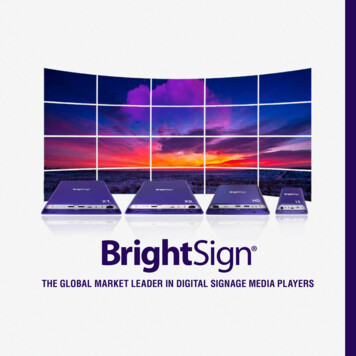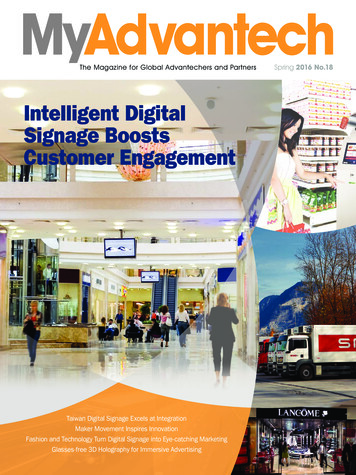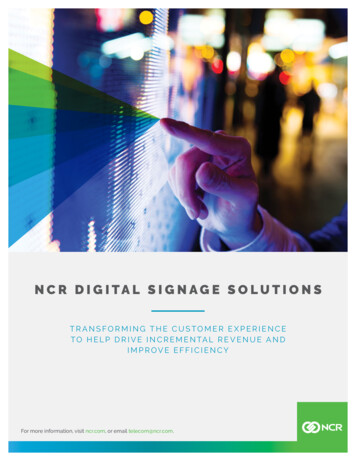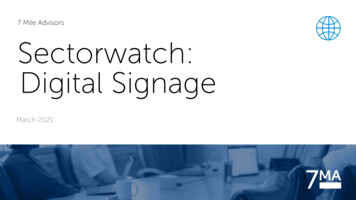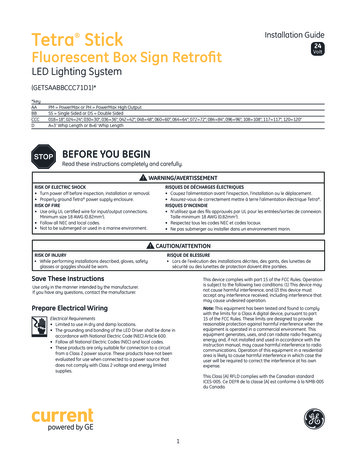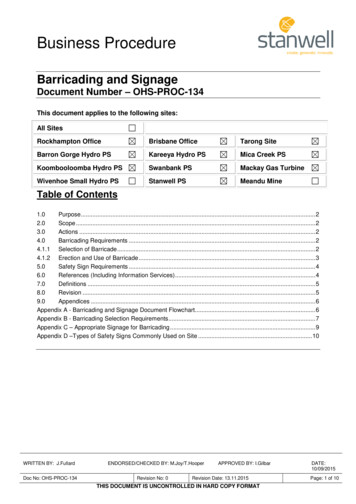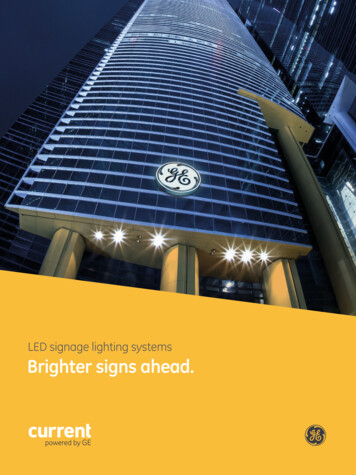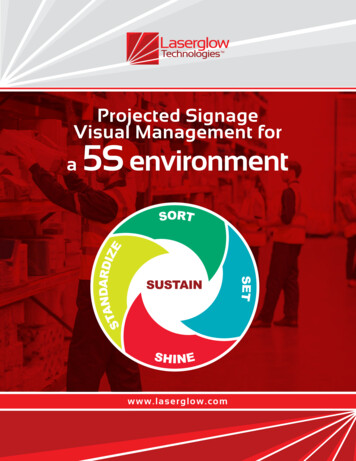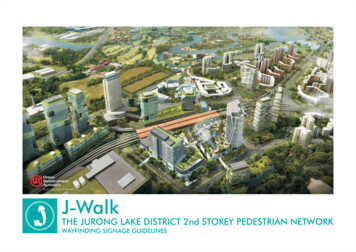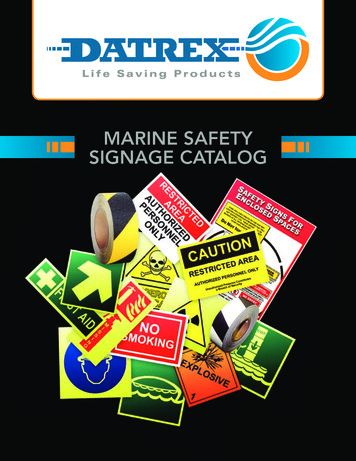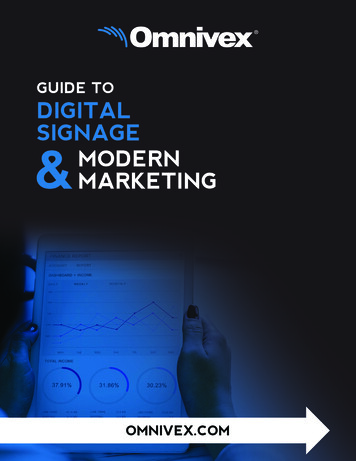
Transcription
GUIDE TODIGITALSIGNAGEMODERNMARKETINGOMNIVEX.COM
GUIDE TO DIGITAL SIGNAGEIN TODAY’S TECHNOLOGY DRIVEN WORLD, digital marketing strategies are rapidly supersedingtraditional marketing methods. Digital signage is a leading tactic as it reaches 70% of the public each year.It’s flexible, allowing for updates and changes, collects data, customizable, and it’s everywhere. Fromretail stores to hospitals, airports to universities, digital signage is empowering audiences. To optimizeimplementation and messaging of digital signage, it is important to consider your strategy, content anddesign, platforms and networking.STRATEGY
STRATEGYYOU HAVE DECIDED YOUR ORGANIZATION NEEDS DIGITAL SIGNAGE. NOW WHAT?Where do you start? What type of Return on Investment can you expect? If you don’t have a strategy for yourdigital communications network then you won’t be able to fully maximize all the benefits and opportunities itpresents. Developing a strategy doesn’t have to be complex or intimidating, but without a strategy you’ve madea big investment with little chance of return. If you want to use your screens to communicate and engage youraudience, then you must be purposeful.DO YOU HAVE ADIGITAL CONTENT STRATEGY?While many organizations may have a goal directly relatedto their digital signage expectations, that doesn’t mean theyactually have a content strategy. Content can often be createdin a vacuum by designers that don’t have any informationabout the audience or where and how the content will be used.To develop a true strategy for your digital signage, there mustbe collaboration between various parties to determine not onlythe visual content, but just as important, the best message,way and location to promote a specific product or service.STRATEGIES YIELD RESULTSDigital displays can influence the viewer’s decisions andactions. That’s not just a hypothesis. Eclipse Digital Mediafound that 29.5 percent of customers said that the contenton digital menus impacted their order. These same displayswere also responsible for a 50 percent boost in sales. Digitalcommunications attract attention, just make sure it’s thekind of attention you want. If you’ve ever been in a store,restaurant, or really any venue, where the digital displaysare either not working or have badly designed content it’snot very impressive and sometimes even distracting. It mayeven have customers questioning the quality of the businessand its brand. A survey from FedEx revealed 68 percent ofconsumers see a store’s digital communication methods asa reflection of its quality. These types of expectations aren’tjust in retail, they apply across all industries.
STRATEGYWHAT MESSAGE DO YOU WANTTO COMMUNICATE?Once you are able to answer this you can build on thatidea. In a retail environment you could use your digitaldisplays to focus on the items or promotions that havebetter margins or have been shown to perform well. In otherenvironments, such as airports, schools or hospitals, wheredigital communications are used for sharing informationlike schedules or wayfinding, consider the user perspectiveand how what you communicate can help or guide them.When you think about how the viewer will intake theinformation, you are more likely to promote a positiveemotional experience, which is very important for the rightresponse. For example, research from the Temkin Grouprelayed that customers who have a positive emotionalexperience with a brand are over 15 times more likely torecommend it, eight times more likely to trust it, and seventimes more likely to make another purchase from them.MUST EMPLOYmultiple touchpointsMUST PROVIDEa digital experienceA PLATFORM TO EXECUTEYOUR STRATEGYMUST BEOnce you have an approach to your communications, muchof the rest of your strategy should focus around finding aplatform that supports your needs now and in the future. It isimportant to find a platform that will enable your organizationto be agile and provide you with the ability to put informationon any screen, from digital displays to desktops to mobilephones. As well, make sure you put some thought into yourcontent strategy. This could mean changing content basedon time of day, day of the week, or season.MUST PROMPTengaginga responseCONTENT AND DESIGN
CONTENT AND DESIGNIN DIGITAL DESIGNyour message should be clear and easy to understand and crafted for a specificaudience. Cool, vivid, stylish, or even flashy—these characteristics aren’t good enough by themselves. Their onlyworth is in their ability to clearly convey your message to the people who need it.So, before starting your next digital signage project, clearly identify who it is you’re trying to communicate withand what it is you want your audience to do. Let the answers to these questions guide you in all of your designand messaging decisions.DESIGNVISUAL CONTRASTVisual contrast is important. Contrast is using color andbrightness and other distinguishing elements to makecertain aspects of your presentation stand out. You shoulduse contrast to create a visual hierarchy that shows viewerswhere to focus their attention. Keep it simple and never losesight of your objective.WHITE SPACEElements on your screen are like people—they need a little roomto breathe, so don’t be afraid of white space. Overcrowding isas uncomfortable on screen as it is in person. Proper use ofwhite space can help focus attention on your message.COLORA splash of color adds instant intrigue to your display,likewise energy and excitement. Simply put, bright andvibrant colors are just plain fun to look at. However, as withany design tool, moderation is key. Too many colors can bedistracting or even off-putting. In most cases, you’ll want tolimit your color palette to a maximum of three colors.
CONTENT AND DESIGNRULE OF THIRDSThe rule of thirds isn’t actually a rule, but rather a simple,easy-to-follow guideline that can help you create moreinteresting compositions. See the digital canvas in thirds—horizontally as well as vertically, like a tic-tac-toe board.Where the lines intersect are good places to position yourmost important visual elements.,Understanding these basic principles of composition willenhance your ability to engage and communicate withyour target audience. They aren’t hard, and you can beginapplying them today.TYPOGRAPHYEffective typography tells the audience what the mostessential information is on the screen before they even realizeit. In fact, the best typography should go unnoticed by thosewho don’t love design. It should work seamlessly. Does yourdigital signage match the rest of your brand, or does it seemout of place? The following is important to consider: Stick to sans serif fonts, they tend to be more readable Consider casing and spacing Pair fonts when a sign needs to convey a lotof information Size matters, think about the distance of the audienceLine heightAFont sizeCONTENT
CONTENT AND DESIGNIN THE WORLD OF DIGITAL SIGNAGE,you’ve probably heard many times that “content is king”.Yet, brands that want to use digital signage to communicate with their audiences often relegate content to thebottom of the priority list, creating a disconnect between the message goals and content outputs. Is your digitalcontent driving interest and engagement or leaving the audience unimpressed? Not all digital content is createdequal. Content and its context matter greatly when attracting attention and conveying information.IS YOUR CONTENT TIME OPTIMIZED?Timing is fundamental to the digestion of content. It isimportant to consider a person’s average attention span,which may be as little as eight seconds. It is also vital toaccount for dwell time. Dwell time relates to the traffic flowof your audience, so message timing must be optimizedaccordingly—roadside digital signage content should beshort enough for passing vehicles to ascertain the intendedmessage, while captive audience dwell time (think airportsecurity lines) can be much longer.IS YOUR CONTENT VISUALLYOPTIMIZED?Content organization is vital to reaching your goals. Organizecontent in a logical manner and optimize the layout. Textshould always stay stationary while imagery can move. As theysay, a picture is worth a thousand words. Wherever possible,represent information as images, icons and charts, rather thantext alone. There are many different types and styles of charts.Choosing the right chart type can make a big difference in thelegibility and comprehension of the underlying data. Bar charts are better than pie charts Use a horizontal bar chart for ranking differentscenarios Use a vertical bar chart for time comparisons Line charts are used for connecting continuous dataon an interval scale Bullet charts are great for showing value vs. targetssuch as KPIsOverall, digital communications can help drive sales andConsider use and audienceincrease audience interaction, but only if designed correctly.Unclear messages can overwhelm audiences and negativelyimpact interest. Alternatively, targeted content can delivereffective messages to boost involvement.IS YOUR CALL TO ACTION WEAKOR NON-EXISTENT?A call to action (CTA) is not just for marketing campaigns.They are a dynamic means to get the most out of digitalsignage, providing a direction for viewers to take. A missing,weak, or irrelevant CTA translates to dead space. Digitalsignage requires investments in capital and resources, so itis important for it to be as focused on conversions as anyother marketing tool employed. Saying, “Buy Now” isn’tnearly as compelling as saying “Take Advantage of thisSweet Deal.” The opportunity to drive action via digitalsignage should not be squandered.IS YOUR CONTENT INTEGRATEDWITH OTHER CHANNELS?Digital signage can be used to do more than engage withviewers. Today, user-generated content is a huge trend, andintegrating digital signage messaging with social mediacan promote deeper connections and turn customers intofans. By offering clever hashtags, inviting customers to tagonsite pictures, or hosting contests asking visitors to createvideos representing what they like about a specific productor service, promotes not only brand visibility, but customerrecognition as well.Must be readable and visually interestingSize White Style Font
PLATFORMS AND NETWORKINGPLATFORMS AND NETWORKINGPOWERFUL DIGITAL COMMUNICATION TOOLS can enable organizations to easily collect, process,and deliver targeted real-time information to optimize its operations. Digital communications allow for effectivemessage dissemination and extends real-time, customized information to everyone within a company.NETWORKED DIGITALCOMMUNICATIONS ARETHE NEW STANDARDIn the early days of digital signage, screens were oftenstandalone displays that didn’t communicate with others.The technology had not matured enough to create a fullyintegrated system. This, coupled with high costs, kept digitaldisplays standalone. However, much has changed sincethen. With the barriers of complex connections and highcosts gone, digital communications can now leverage data tocreate relevant and personalized experiences. The standardis for all displays and content to live on one network. Thedays of the standalone displays are officially dead. In its placeis the ability for any space to be connected digitally — fromcampuses to offices to hospitals - to just about anywhere.
PLATFORMS AND NETWORKINGCONNECTED NETWORKSSTREAMLINE CONTENT CREATIONBefore the connected era, standalone displays requiredevery screen “owner” to create their own content. This wasinefficient, time-consuming, and the content often wasinconsistent. It created communications silos, where eachinstallation had no ability to talk to another or share content.A connected system changes all of that. With a network, youhave the ability to create content on a standardized templateand share it across all of your screens.For example, hospitals, which are often massive in size andhave multiple buildings, can connect every display on onenetwork. Each department or group at the facility may beresponsible for their content, but the content is now cohesiveand usable on any screen. Welcome screens may add somecontent from the food service screens announcing lunchspecials. Or, the digital screens in the cafeteria may run areminder to complete a satisfaction survey or get a flu shot.Networking your digital signage improves branding, allows formessaging to be unified and creates opportunities for crosspromotion. It’s also a significant time saver, streamlining theprocess can equate to significant time and cost savings.IOT DEVICES’ DATA COLLECTIONINFLUENCES DIGITAL COMMUNICATIONSA major part of any connected space today is IoT (Internet ofThings) devices. These devices are capable of making thingseasier for those in the spaces. They can track and store dataas well as communicate with digital displays. That data is thenpublishable via digital communications. In terms of security andsafety, sensor data could prompt real-time communicationson every screen. Whether it is a fire alarm or other safety alarmstriggered by disasters like tornadoes or hurricanes, a digitalnetwork can enable a quick, systemwide message.DIGITAL COMMUNICATIONS enableorganizations to share information while addingvalue and improving the customer experience. Nomatter your business, the perfect digital tools willfree up time, labor, and financial resources so thatyou can focus on your core mission.CREATE,CONNECT,DISTRIBUTEand PRESENTreal-time information,on any screen, withOMNIVEXLEARN MORE about growing your digitalcommunications strategies and building solutionsto drive action and deliver results atOMNIVEX.COM
To develop a true strategy for your digital signage, there must be collaboration between various parties to determine not only the visual content, but just as important, the best message, way and location to promote a specific product or service. Digital displays can influence the viewer’s decisions and actions. That’s not just a hypothesis. Eclipse Digital Media found that 29.5 percent of .
